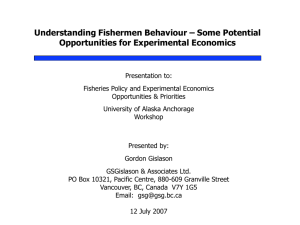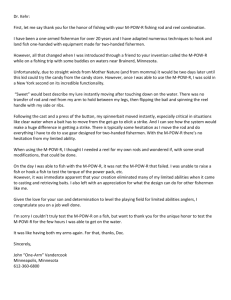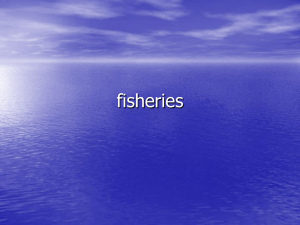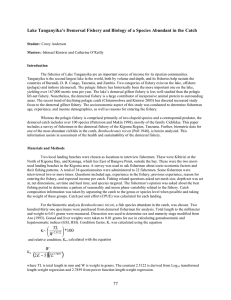A Survey of the Demersal Fishery in the Kigoma Area
advertisement
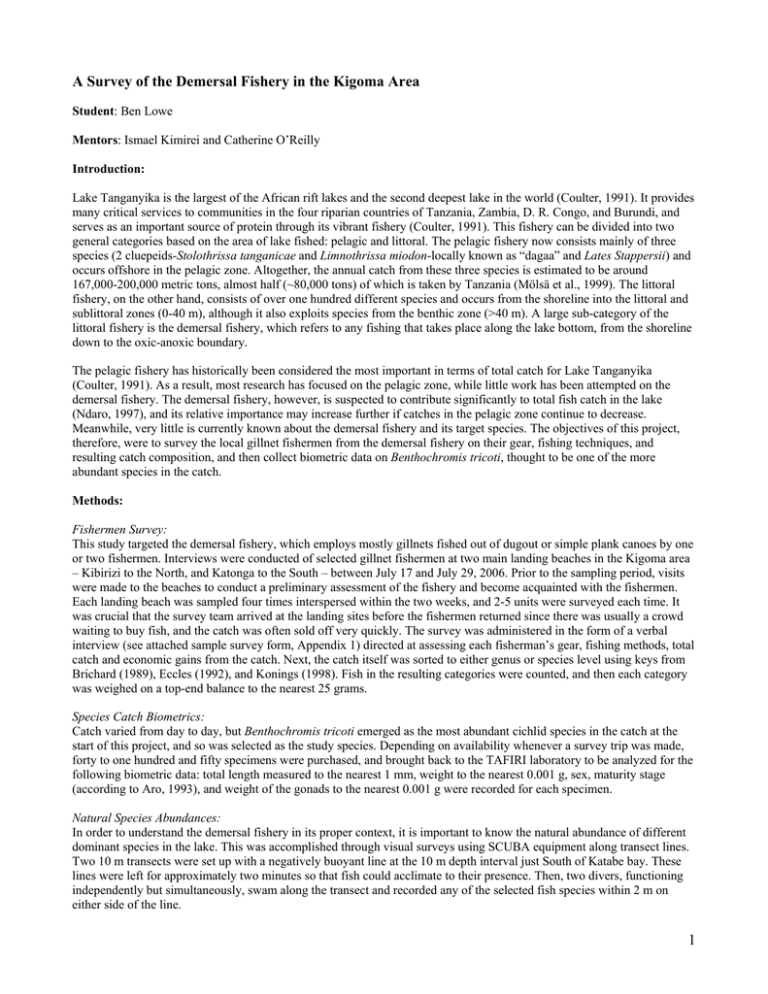
A Survey of the Demersal Fishery in the Kigoma Area Student: Ben Lowe Mentors: Ismael Kimirei and Catherine O’Reilly Introduction: Lake Tanganyika is the largest of the African rift lakes and the second deepest lake in the world (Coulter, 1991). It provides many critical services to communities in the four riparian countries of Tanzania, Zambia, D. R. Congo, and Burundi, and serves as an important source of protein through its vibrant fishery (Coulter, 1991). This fishery can be divided into two general categories based on the area of lake fished: pelagic and littoral. The pelagic fishery now consists mainly of three species (2 cluepeids-Stolothrissa tanganicae and Limnothrissa miodon-locally known as “dagaa” and Lates Stappersii) and occurs offshore in the pelagic zone. Altogether, the annual catch from these three species is estimated to be around 167,000-200,000 metric tons, almost half (~80,000 tons) of which is taken by Tanzania (Mölsä et al., 1999). The littoral fishery, on the other hand, consists of over one hundred different species and occurs from the shoreline into the littoral and sublittoral zones (0-40 m), although it also exploits species from the benthic zone (>40 m). A large sub-category of the littoral fishery is the demersal fishery, which refers to any fishing that takes place along the lake bottom, from the shoreline down to the oxic-anoxic boundary. The pelagic fishery has historically been considered the most important in terms of total catch for Lake Tanganyika (Coulter, 1991). As a result, most research has focused on the pelagic zone, while little work has been attempted on the demersal fishery. The demersal fishery, however, is suspected to contribute significantly to total fish catch in the lake (Ndaro, 1997), and its relative importance may increase further if catches in the pelagic zone continue to decrease. Meanwhile, very little is currently known about the demersal fishery and its target species. The objectives of this project, therefore, were to survey the local gillnet fishermen from the demersal fishery on their gear, fishing techniques, and resulting catch composition, and then collect biometric data on Benthochromis tricoti, thought to be one of the more abundant species in the catch. Methods: Fishermen Survey: This study targeted the demersal fishery, which employs mostly gillnets fished out of dugout or simple plank canoes by one or two fishermen. Interviews were conducted of selected gillnet fishermen at two main landing beaches in the Kigoma area – Kibirizi to the North, and Katonga to the South – between July 17 and July 29, 2006. Prior to the sampling period, visits were made to the beaches to conduct a preliminary assessment of the fishery and become acquainted with the fishermen. Each landing beach was sampled four times interspersed within the two weeks, and 2-5 units were surveyed each time. It was crucial that the survey team arrived at the landing sites before the fishermen returned since there was usually a crowd waiting to buy fish, and the catch was often sold off very quickly. The survey was administered in the form of a verbal interview (see attached sample survey form, Appendix 1) directed at assessing each fisherman’s gear, fishing methods, total catch and economic gains from the catch. Next, the catch itself was sorted to either genus or species level using keys from Brichard (1989), Eccles (1992), and Konings (1998). Fish in the resulting categories were counted, and then each category was weighed on a top-end balance to the nearest 25 grams. Species Catch Biometrics: Catch varied from day to day, but Benthochromis tricoti emerged as the most abundant cichlid species in the catch at the start of this project, and so was selected as the study species. Depending on availability whenever a survey trip was made, forty to one hundred and fifty specimens were purchased, and brought back to the TAFIRI laboratory to be analyzed for the following biometric data: total length measured to the nearest 1 mm, weight to the nearest 0.001 g, sex, maturity stage (according to Aro, 1993), and weight of the gonads to the nearest 0.001 g were recorded for each specimen. Natural Species Abundances: In order to understand the demersal fishery in its proper context, it is important to know the natural abundance of different dominant species in the lake. This was accomplished through visual surveys using SCUBA equipment along transect lines. Two 10 m transects were set up with a negatively buoyant line at the 10 m depth interval just South of Katabe bay. These lines were left for approximately two minutes so that fish could acclimate to their presence. Then, two divers, functioning independently but simultaneously, swam along the transect and recorded any of the selected fish species within 2 m on either side of the line. 1 Results: Fishermen Survey: 1. Fishing Parameters: A total of 31 fishermen surveys were conducted, although 8 fishermen were surveyed on two or more trips, resulting in a total of 22 different fishermen being surveyed. Out of this pool, 13 (59.1%) fishermen used dugout canoes and 9 (40.9%) used simple plank canoes, both known as “mtumbwi” in Kiswahili. Both types of vessels are similar in size and weight and it was assumed that canoe type does not significantly affect the catch. Unlike in the pelagic fishery, where multiple boats often cooperate together as one fishing unit, each unit sampled in the demersal fishery consisted of only one canoe operated by one to two fishermen. Gillnets were all constructed with nylon (monofilament nets are banned in Tanzania) and varied in mesh size, length, and width (Table 1). Mesh size ranged from 1” to 4” and was usually around 2”, while net length ranged from 700 m up to 3000 m but averaged 1573 m. Width of the gillnet varied the least among the above-mentioned parameters. In 20 out of 22 cases, the width was given as 26 mesh squares, or approximately 2 m. In the two exceptions, net width was 1 m and 1.5 m respectively. Fishing depth varied widely, from 4 m down to 200 m, and we did not observe any pattern based on date/moon phase or landing beach. Fishing duration (the time lapsed between when the nets were set and hauled) also varied widely (between 0930 to 2200 hours), although fishing trips were always an overnight event; nets were set sometime during the afternoon/evening and hauled early in the morning on the next day. 2. Catch Composition: A total of 36 fish genera representing 9 families were identified in the gillnet catch from both Katonga and Kibirizi (Table 2). The family Cichlidae was most often represented, and comprised 24 out of the 36 genera. Overall, 24 genera were identified down to species level. The remaining 12 categories were identified down to genus level, and these often contained multiple species. In many cases, such as with the Tropheus and Chyrsichthys genera, it was not feasible to identify fish down to their species names while on the beach. An “unknown” category with 14 fish contains various species that could not be identified down to the genus level. 30 of these genera were recorded in Katonga, including the following five not found at Kibirizi: Barbus spp., Afromastacembelus moorii, Phyllonemus typus, Cyathopharynx furcifer, and Altolamprologus compressiceps. In Kibirizi, 31 genera were recorded, the following six which were not found at Katonga: Auchenoglanis occidentalis, Simochromis spp., Tylochromis polylepis, Altolamprologus spp., Labeo spp., and Cyprinochromis spp. The two most dominant species in the total catch were Limnotilapia dardennei, and Benthochromis tricoti. These two species together contributed an average of 44.6% of the catch by number, and 35.6% by weight (Table 3). The genus Afromastacembelus (Afromastacembelus cunningtoni in particular) and Chrysichthys were both also heavily represented in the catches. When the landing beaches are considered separately, however, B. tricoti is most dominant at Katonga and L. dardennei is most dominant at Kibirizi (Table 3). At both locations, all the cichlid species together comprised over 70% of the catch by number. Variables that affected catches the most were mesh size and fishing depth. Three fishermen (two at Katonga, and one at Kibirizi) used mesh sizes up to 4” and their catch was comprised of fewer, but much larger fish (mainly Lates mariae, Boulengerochromis microlepis, Chyrsicthys spp., and other catfishes). The average weight for these three catches is 5213 g compared to an average of 3971 g for the remaining thirty catches. Increasing depth had no significant effect on the number of species in catches, but did tend to increase the catch weight (Figure 1). 3. Socioeconomic Findings: Fishermen come from many different backgrounds and vary widely in age, years of experience, and expected income per catch (Table 4). Fishing does not require any formal education although fishermen surveyed for this project all demonstrated a strong informal knowledge base (‘local knowledge’) of the fishery and fish species. When asked what variables affect their catch rate, 9 out of 13 fishermen (69 %) responded that their catches are usually much better during the wet season. Six of these fishermen also responded that moon phase affects catch success, but these were evenly divided into three groups based on whether catches were better during a full moon (brighter), better with an obstructed moon (darker), or simply varied nonspecifically with moon phase. The average catch per unit effort (CPUE) (measured in kg/fisherman/day) was 5.3 for Katonga, 3.1 for Kibirizi, and 4.1 when the two sites are combined. Species Catch Biometrics: Benthochromis tricoti Benthochromis tricoti was more abundant in catches sampled at Katonga (385 specimens total, 42%) than at Kibirizi (156 specimens, 15%), and numbers per catch show a significant positive correlation (R2=0.45, p<0.0001) with fishing depth for both beaches combined (Figure 2). A total of 378 specimens of B. tricoti were obtained for biometric data from fishermen and the fish market over five mornings during the survey period. The sex ratio was calculated to be 1.4 females for every male and almost all specimens were found to be mature adults (Table 5). As a result, the length (TL) and weight distributions were clustered closely around the mean length of 165.3 mm and weight of 34.3 g (Figures 3-4). The lengthweight relationship follows the standard growth equation W = aLb, where ‘W’ is weight, ‘L’ is total length, and ‘a’ and ‘b’ 2 were found to be 0.0002 and 2.33 respectively (Figure 5). Length (TL) data was also used to estimate population parameters for the species based on models on FISHBASE 2004 (Froese & Pauly, 2000) and FiSAT II (Gayanilo et al., 2002). Natural Species Abundance: (Appendix 2) The results of the two dive transects are considered too preliminary to include as data in this study. As such, the results are attached to the end of this paper for reference purposes but will not be discussed further. Discussion: Fishermen Survey: 1. Fishing Parameters: According to Mgana (2004), there are approximately 41 demersal fishermen in the Kigoma area and the vast majority (36) fish with gillnets. This study surveyed twenty-two fishermen, or about half of the local fishery, but did not include the smaller landing beaches of Kigodeko, Katabe, and Ujiji. The fishing gear used is very simple and often in poor condition. Net length is probably limited by available financial resources, and nets are often old and contain large, unpatched holes. Most fishermen use smaller mesh sizes and are usually assured of a catch. The three fishermen who did use a large mesh size risked a low numeric catch, but anything caught was often very large and potentially more profitable in the market than the catches from smaller mesh sizes. 2. Catch Composition: Different fish species inhabit different depth ranges, and there is usually a greater abundance of species in shallow, littoral habitats than in the deeper benthic areas (Brichard, 1989). Nonetheless, there was no significant relationship between number of species and fishing depth. Instead the surveys reflected a positive correlation between catch weight and increasing depth. This is due to Afromastacembelus cunningtoni and the genus Chrysichthys, which range into greater depths than many of the cichlid species, and often add a lot of weight to a catch due to their relatively large sizes. Fishing depth was deeper than expected in some instances – down to 200 m – and far exceeded the oxycline depth of 60-70 m observed in the pelagic area during the same period (Rajabu, this volume). A possible explanation for this observation is that the drop line down to the nets may not have hung vertically, resulting in an actual fishing depth significantly shallower than 200 m. Fishing depth was often varied between trips, but fishermen usually did not have any explanation for these changes, and they did not form any discernable pattern (such as correlating with moon phase) during this short sampling period. A total of 36 fish genera were identified during this study, compared with 78 species from Bayona (1991) and 104 for Kuwamura (1987) in the same region. Bayona (1991) and Kuwamura (1987) both used beach seines as their primary fishing gear, unlike this survey where all the data were collected from gill-netters. In addition, Kuwamura (1987) used other fishing methods such as SCUBA diving and angling. Beach seines are much less selective and more thorough than gillnets, and so trap more species as well. Since both studies were published, however, beach seining has been banned in the Tanzanian part of Lake Tanganyika, and so is much less prevalent now (although illegal fishing with beach seines does still exist, done mainly at night to avoid being caught by enforcement authorities). Thus, gillnet surveys give a more accurate picture of the demersal fishery, but are biased based on mesh size (a form of selectivity in sampling), and do not necessarily represent actual diversity in the demersal zone (Sparre and Venema, 1998). It should also be noted that more than 36 species were observed, but many of the individuals could not be identified down to the species level because of time constraints from sampling multiple catches before they were sold or brought into the market. In addition, some specimens were damaged by crabs or during removal from the nets, and so accurate identification was again not possible. In the beginning of the survey period, Benthochromis tricoti was the most abundant catch species at both beaches. This changed over time as more fishermen were fishing at shallower depths and Limnotilapia dardennei became more dominant in some catches, especially at Kibirizi. Local knowledge from some of the fishermen interviewed is that the Limnotilapia dardennei catch varies with moon phase, with poorer catches around a full moon. A possible explanation for this phenomenon is that a full moon may provide enough light in the shallows for Limnotilapia dardennei to see the gillnets, and thus avoid being caught. 3. Socioeconomics: The gear needed for a demersal fishing unit is much cheaper and simpler than for a pelagic unit. In the demersal fishery, a unit comprises of a canoe (with paddles, about 20,000-40,000Tshs) and a gillnet (currently 1000Tshs/50m, or around 20, 000-60,000Tshs). All other material, such as weights and floats are obtained from available scraps and natural materials. The total estimated startup costs to become a demersal fishermen therefore adds up to around 40,000-100,000Tsh. In 3 comparison, a unit in the pelagic fishery usually comprises at least two larger boats (subtotal 1-2 millionTshs), outboard motors (subtotal 2-4 millionTshs), a lift net (500,000Tshs), and at least 10 lanterns (subtotal 200,000 –250,000Tsh), for a total estimated startup cost around 3,700,000-6,750,000Tsh. This does not take into account the cost of kerosene (1015l/trip at 1,300Tshs/l) and petrol (40-80l/trip at 1,500Tshs/l). (Note: The current exchange rate is US$1 to 1,200Tshs.) Another consideration is the catch per unit effort (CPUE) (kg/fishing unit/trip), which was found to average 4.1 between the demersal fishery at Kibirizi and Katonga. This is compared to an average CPUE of around 300 for the pelagic fishery in Kibirizi and Katonga, obtained during a previous study in July, 2003 (Kimirei, 2004). When broken down from fishing unit to individual fishermen, however, average CPUE is still around 4.1 for the demersal fishery (mostly single fishermen units) but drops to 3.7 for the pelagic fishery (assuming an average of 8 fishermen per unit). Furthermore, profits from the pelagic fishery are distributed unequally according to rank (owner, boat captain, etc.). Given these discrepancies, the demersal fishery is more accessible to someone with less money who prefers not to work under an owner as part of a pelagic crew. With its relatively small investment cost, participating in the demersal fishery may also be ideal for supplementing other seasonal incomes such as farming or tourism. Species Catch Biometrics: Benthochromis tricoti No population parameters currently exist in the literature or databases (such as FishBase 2004) on many important fish species in the demersal fishery on Lake Tanganyika. Since Benthochromis tricoti is one of the species lacking information, data from this study could potentially begin to fill that need. It is important to note, however, that biometric data was collected from samples in the catch only and is a biased data set of mostly mature specimens. At the same time, this is a positive sign for the sustainability of B. tricoti populations with respect to the gillnet fishery, because it reflects that many fish have already spawned before they are caught, and no juveniles are being harvested. Even when mature, though, B. tricoti tends to have relatively small, indistinct gonads that can make staging and weighing gonads challenging. An aid in estimating maturity lies in the display of sexual dimorphism among mature individuals, with males developing wispy fins and colorful sheens and females remaining plain with silver-gray sides. For a more complete picture of population parameters, data is still needed for juveniles and maturing individuals (stages 1-3 of Aro, 1993). Preliminary Conclusions and Recommendations: The demersal fishery is an important fishery in the Kigoma area and catches form a substantial component in the daily fish market. Specifically, cichlid species such as Benthochromis tricoti are a popular food item and an important source of protein for the local communities. An important next-step in understanding the specifics of this fishery would be to conduct long-term studies that include variations based on moon phase and local seasons. Meanwhile, there are many known threats to sustainability within the demersal fishery. Concern was raised that the practice of beach seining was overharvesting the demersal fishes and depleting juvenile stocks of many cichlid species (Ndaro, 1992, 1997; Bayona, 1991). In particular, Bayona (1991) conducted surveys in Kigoma using a beach seine with a mesh size of 50.8 mm/2” (wings) and 6.35 mm/0.25” (cod end) and found that juvenile cichlids comprised 75.9% of the total catch by number, and 26.7% by weight. Since beach seining was banned, its practice has plummeted, and fisheries officers actively confiscate nets and penalize the offenders. As the dominant fishing gear now, gillnets can be much more selective in targeting specific sizes of fish and thus avoid overharvesting the demersal fish stocks. This is demonstrated by the catch biometrics from B. tricoti. Using a mesh size of 2”, identical with the beach seine wing mesh size used by Bayona (1992), fishermen only caught adult individuals of B. tricoti, and few or no juveniles of other species. This change in size composition could be explained by the smaller mesh size at the cod end of beach seines (0.25”) and the passive fishing nature of gillnets as opposed to the active nature of beach seines (Sparre and Venema, 1998). Another significant factor resulting in fewer juveniles being taken is probably the difference in fishing depth between the two gears. Gillnet catches with B. tricoti tended to come from depths of 50-200 m, which is beyond the depth range of normal beach seines. When gillnet fishermen targeted shallower waters, however, juvenile fish did start showing up in greater numbers in the catch, although still not at the rates of 75.9% of the total catch. Few fishermen used intermediate mesh sizes of 3”, and most fishermen who did include large mesh sizes also used smaller sizes in other parts of the net. Results from ongoing experimental gillnet fishing that just started in late July, 2006, through the Kigoma Branch of TAFIRI will be helpful in determining which mesh sizes are more effective at catching sufficient numbers of adult fish while eliminating most juveniles from the catch. In the meantime, fishermen should focus their fishing efforts in deeper waters (preferably >40 m, but certainly >20 m), away from the shallow nursery grounds of many demersal and pelagic fish species. One possible way to implement this measure would be to designate significant amounts of critical shoreline within the 0-40 m depth range as underwater reserves. This way, even if limited fishing is permitted, it could be carefully managed with minimum mesh size regulations (perhaps 3”). 4 Another step towards ensuring the sustainability of the demersal fishery would be to encourage the release of juveniles, especially of selected species such as Boulengerochromis microlepis. This large species of cichlid is a highly prized food fish and fetches a high price in fish markets. Recently, however, B. microlepis has become scarce, with overfishing being the suspected culprit. Although some adult-sized specimens were observed in surveyed catches, the majority were juveniles. Heavy fishing pressure, along with the indiscriminate harvesting of juveniles, presents serious challenges to the sustainability of this and many other fish species. Furthermore, although no such observations were made during this study, the potential still exists for fishermen to begin switching from the pelagic fishery into the demersal fishery if the pelagic catch continues to decrease. This increased fishing pressure could eventually cause a similar crash of demersal fish stocks. Releasing juveniles would help fish stocks rejuvenate, and studies should be conducted on the catch and release survival rates of juveniles from gillnets. Perhaps the solution with greatest potential for long-term success would be to develop a local conservation ethic among fishermen and buyers in the markets from the grassroots level. If this is established, a standing committee representing major stakeholders in the fishery can begin to review recommendations from researchers and pass regulations that everyone agrees to abide by. These regulations can start with a minimum size limit for fish species of special concern, but could later come to include closed seasons during breeding months or gear specifications. Another potential function of this committee could be to partner with fisheries scientists to begin building an extensive local fisheries database. This would be accomplished by providing basic training for fishermen in species identification (so that there is a standard) and data collection. Fishermen who complete this training would then be rewarded for monitoring their catches and reporting this data to a clearinghouse agency such as TAFIRI. Acknowledgements: This work would not be possible without the gracious help of many people. I would like to thank my mentors, Ismael Kimirei and Catherine O’Reilly, for their fearless leadership and patient support. Jennifer Schmitz took many of the photos used in this study and was an encouraging and helpful presence during trips to the landing beaches. George Kazumbe was also of indispensable assistance in leading the fish transect dive and helping us identify baffling fish species. I am very grateful to TAFIRI for a warm welcome and the use of their facilities. Specifically, I am indebted to Huruma Mgana, Baraka Sekadende, and the UDSM Fisheries students for their warm friendship and crucial help with processing samples. Finally, many thanks to my persevering research partner, Anthony Kalangali, for his dedicated work and long hours spent smelling like fish with me. This project was made possible by the hard work of the Nyanza Project leadership, and through generous funding by the NSF (grants ATM 0223920 and DBI-0608774). Literature Cited: Aro, E. 1993. Guidelines for sampling pelagic fish catches on Lake Tanganyika. FAO/FINNIDA Research for the Management of the Fisheries on Lake Tanganyika. GCP/RAF/271/FIN-FM/04 Bayona, J. D. R. 1991. Species Composition and Some Observations on the Littoral Fishes Based on Beach-Seining in the Kigoma Region, Eastern Coast of Lake Tanganyika. African Study Monographs, 12(2): 75-86. Brichard, P. 1989. Cichlids and all other fishes of Lake Tanganyika. TFH Press. Coulter, G.W. (Editor). 1991. Lake Tanganyika and its Life. Natural history publication, Oxford University Press, London. Eccles, D.H. 1992. FAO species identification sheets for fishery purposes. Field guide to the freshwater fishes of Tanzania. Rome, FAO. Froese, R., & Pauly, D. 2000. FISHBASE 2004: Concepts, Design, and Data Sources. Philippines. ICLARM Gayanilo, Jr. F. C., P. Sparre, & D. Pauly. 2002. FISAT II. Rome, FAO. Kimirei, I.A. 2004. Variability in Pelagic Fish Catches and the Physico-chemical Parameters in Kigoma Bay, Lake Tanganyika, Tanzania (MSc thesis). University of Dar Es Salaam. Konings, A. 1998. Tanganyika Cichlids in their natural habitat. Cichlid Press. Kuwamura, T. 1987. Distribution of Fishes in Relation to the Depth and Substrate at Myako, East-middle Coast of Lake Tanganyika. African Study Monographs, 7:1-14. Mgana, H. 2004. Estimation of Fish Abundance and Catches in Littoral Habitats of Kigoma Bay. The Nyanza Project 2004 Annual Report. Mölsä, H., Reynolds, J. E., Coenen, E. J., and Lindqvist, O. V., 1999. Fisheries research towards resource management of Lake Tanganyika. Hydrobiologia, 407: 1-24. Ndaro, S.G.M. 1992. Nearshore Fish Resources and Fisheries Around Kigoma, East Coast of Lake Tanganyika. Naga, ICLARM 15(2): 35-38. Ndaro, S.G.M. 1997. The inshore demersal fish species of the eastern part of Lake Tanganyika and their need for conservation. In section IV, p135 of Jiddawi, N.S. and R.D. Stanley. 1999, editors. Fisheries Stock Assessment in the Traditional Fishery Sector: The Information Needs. Proceedings of the National Workshop on the Artisanal Fisheries Sector, Zanzibar. September 22-24, 1997, Zanzibar, Tanzania. Rajabu, F. 2006. Variations of physical –chemical parameters and nutrients in the pelagic zone of Kigoma Bay, Lake Tanganyika. The Nyanza Project 2006 Annual Report. Sparre, P. & Venema, S.C. 1998. Introduction to tropical fish stock assessment. Part 1. Manual. FAO Fisheries Technical Paper. No. 306.1, Rev. 2. Rome, FAO. 5 Table 1. Fishing Parameters: Sample size varies based on whether the respective parameter was held constant across the surveys (Mesh Size, Net Length, and Width) or varied with each fishing trip (Depth and Duration). Mesh Size has an especially large sample size because some fishermen incorporated multiple mesh sizes in one net. Duration is missing a sample because the data was omitted from one survey. Mesh Size(in): Net Length (m): Width (m): Depth (m): Duration (hrs): Average: 2.12 1573 1.98 67 14 Maximum: 4 3000 2 200 22 Minimum: 1 700 1.5 4 9.5 S. Dev. 0.65 638 0.11 62 2.82 Sample size: 35 22 22 31 30 Table 2: Species Catch Composition table in separate file. Table 3. Summarized Catch Composition Percentages: KA Species Name: # Wt. Limnotilapia dardennei 6.2 5.8 Benthochromis tricoti 42.6 22.0 Afromastacembelus 17.8 6.9 Chrysicthys 10.1 14.2 Other Cichlidae 21.6 25.7 Other Non-cichlidae 18.6 8.5 KI # 26.0 14.9 1.1 10.0 38.4 8.2 Wt. 36.2 8.4 3.2 7.1 32.2 13.0 Combined # Wt. 16.8 20.0 27.8 15.6 3.8 10.9 10.1 10.9 32.5 26.6 9.0 16.0 Table 4. Socioeconomic Parameters: Sample sizes are 22 for Age and Experience, and 19 for Income/Catch. Experience Income/catch Age (yrs): (yrs): (Tsh): Average: 37 18.1 3400 Maximum: 63 54 15000 Minimum: 18 1.5 0 Table 5. Maturity of B. tricoti catch samples: Stage number in parentheses according to Aro 1993. Females: Males: Spent (5) 190 1 110 Reproduction (4) 24 Maturity (3) 1 33 Maturaton (2) 0 3 Immature (1) 0 0 Unstaged (rotted) 4 12 Totals: 219 159 Table 6: Population Parameters for B. tricoti. Length measurements are in millimeters, while K and Z reflect the proportion of the population. The Betalamffy growth formula was used to estimate L∞ in FISAT, and the Beverton & Holt method was used to calculate Total Mortality. FISAT II (Gayanilo et al. 2002): FISHBASE (Froese et al.): Inputted Max. Observed Length 197 197 Length-at-infinity (L∞) 210 200.4 86.6 Length-at-first-maturity (Lm): Males Length-at-first-maturity (Lm): Females 102.9 0.08 Growth Coefficient/Year (K) Total Mortality/Year (Z) 0.082 0.22 6 Total Catch (g) Total Catch vs. Depth y = 18.323x + 2863.3 R2 = 0.2068 F=7.56, p=0.01 12000 10000 8000 6000 4000 2000 0 0 50 100 150 200 250 Depth (m) Fisherman sampled Linear (Fisherman sampled) Figure 1. Total weight of catches as fishing depth varies. No. of B. tricoti / catch Total B. tricoti Catch vs. depth 160 140 120 100 80 60 40 20 0 y = 0.3849x - 6.1664 R2 = 0.4488 F = 23.61, p<0.0001 0 50 100 150 200 250 Fishing Depth (m ) Fisherman sampled Linear (Fisherman sampled) Figure 2. Total catch of Benthochromis tricoti increases with depth. Length Distribution of B. tricoti 100 Frequency 80 60 40 20 Frequency 20 0 19 0 18 0 17 0 16 0 15 0 14 0 13 0 12 0 0 Length (m m ) Figure 3. Length distributions in B. tricoti samples from the demersal catch. 7 Weight Distribution in B. tricoti 140 Frequency 120 100 80 60 40 20 0 20 25 30 35 40 45 50 55 60 65 M ore Weight (g) Frequency Figure 4. Weight distributions in B. tricoti samples from the demersal catch. Size Relationship in Benthochromis tricoti 70 y = 0.0002x2.3313 R2 = 0.5819 Weight (g) 60 50 40 30 20 10 0 100 120 140 160 180 200 220 Length (mm) Series1 Power (Series1) Figure 5. Length-weight relationship in Benthochromis tricoti, with a regression line added. 8

